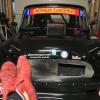Measuring Valve Lift At Tdc
#1

Posted 02 April 2025 - 06:36 AM
Could someone with good experience of this please help explain this;
What is the procedure for accurately measuring valve lift at TDC (as accurately as possible with engine in and head on)?
Firstly with finding TDC, is this best to do in this case with a rod down a plug hole, and checking with a DTI gauge?
Then how is the valve lift best measured/calculated?
Thanks!
Joe
#2

Posted 02 April 2025 - 07:58 AM
DTI with a long extension piece works for finding TDC

to measure valve lift (..as opposed to cam lift..) simply measure off the spring cap

i'm curious: what are you trying to find out ?
#3

Posted 02 April 2025 - 11:46 AM
#4

Posted 02 April 2025 - 11:58 AM
Well first you need to find TDC
the best way is to fit a stop in the spark plug hole, then carefully rotate the engine to the stop. Mark pulley. The rotate the engine the other way till stop. Mark pulley. Then divide the distance and mark. That is TDC. You can do the same with the DTI measuring either side of TDC. Trying to read TDC directly is just about impossible due to the lack of vertical movement of the piston as it passes TDC.
#5

Posted 02 April 2025 - 12:29 PM
If you are going to use your DTI to find TDC I would not use the bonnet slam panel as the datum, use a convenient datum on the engine itself.
#6

Posted 02 April 2025 - 12:41 PM
#7

Posted 02 April 2025 - 04:16 PM
im going this on my volvo engine now, use a piston stop, smash an old plug and weld a nut onto it and threw a bolt threw it. bring it up to the stop, put your deg finder on 0 then turn the engine around the other way, and if you have 10 degs, set it at 5 then go back and do it the other way.
If you use a dti its hard to find true top dead as there is a little lul spot where the piston hardly moves and the crank is still.
#8

Posted 02 April 2025 - 05:38 PM
Well first you need to find TDC
the best way is to fit a stop in the spark plug hole, then carefully rotate the engine to the stop. Mark pulley. The rotate the engine the other way till stop. Mark pulley. Then divide the distance and mark. That is TDC. You can do the same with the DTI measuring either side of TDC. Trying to read TDC directly is just about impossible due to the lack of vertical movement of the piston as it passes TDC.
Nicklouse basically has this down pat, but you must have a datum point to work from, you could use the original timing marks and a bit of tape on the pulley, I flexible steel rule makes things easy to measure, the more accurate the measuring and marking the better things will work out. You can just make out the pointer I made up ( although this was for timing )
Shooter
Attached Files
#9

Posted Yesterday, 09:19 AM
#10

Posted Yesterday, 06:39 PM
this is a handy tool for creating a timing tape you can stick to the crank pulley
https://www.blocklayer.com/timing-tape
#11

Posted Yesterday, 08:45 PM

Edited by timmy850, Yesterday, 08:47 PM.
#12

Posted Yesterday, 09:08 PM
That's good, but might take a few goes to get bang on for the circumference. I used a CD & printed a label, though that has drawbacks too, especially if you have a side radiator fitted.
Could be pedantic, but why?
If you're looking at cam timing it's not the lift at tdc, but where maximum valve lift occurs, relative to tdc, in terms of degrees of crank rotation.
A piston stop is ok, but you will want to turn the engine in the correct (running) rotation to eliminate any slack in the timing gear. So either use a dial gauge to measure equal piston travel before & after tdc. Or start with the piston against stop after tdc & turn the engine clockwise (viewed from the water pump end) until to reach the stop again before tdc
1 user(s) are reading this topic
0 members, 1 guests, 0 anonymous users


















